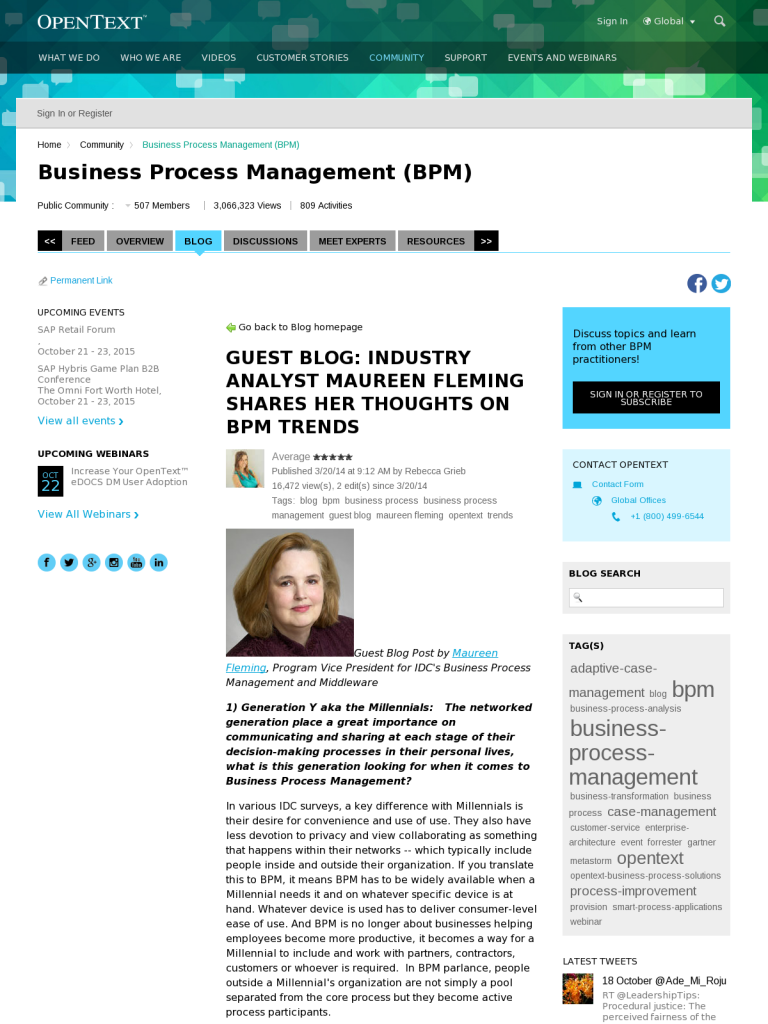Guest Blog: Industry Analyst Maureen Fleming Shares Her Thoughts on BPM Trends
Blog: OpenText
Date:
Thu, 20 Mar 2014 09:12:00 GMT-05:00
From:
rgrieb
Guest
Blog Post by Maureen
Fleming, Program Vice President for IDC’s Business Process
Management and Middleware
1) Generation Y aka the Millennials: The networked generation
place a great importance on communicating and sharing at each
stage of their decision-making processes in their personal lives,
what is this generation looking for when it comes to Business
Process Management?
In various IDC surveys, a key difference with Millennials is their
desire for convenience and use of use. They also have less devotion to
privacy and view collaborating as something that happens within their
networks — which typically include people inside and outside their
organization. If you translate this to BPM, it means BPM has to be
widely available when a Millennial needs it and on whatever specific
device is at hand. Whatever device is used has to deliver
consumer-level ease of use. And BPM is no longer about businesses
helping employees become more productive, it becomes a way for a
Millennial to include and work with partners, contractors, customers
or whoever is required. In BPM parlance, people outside a
Millennial’s organization are not simply a pool separated from the
core process but they become active process participants.
2) What are the specific challenges with case management vs.
process automation. Is there an increase in Case Structures vs
process structures, and how does that affect the tools used for automation?
Our dependence on end-to-end workflow is decreasing and the use of
cases and case management is growing. At IDC, we don’t view process
automation and case management as a religious war or even separate. We
view both as process automation technology, supporting different use cases.
We’ve all learned with BPM that many of our processes tend to work
better when they’re more dynamic. Large, monolithic, workflow-centric
models are not always the best way to operate dynamically.
Additionally, many enterprises face challenges when they need to
upgrade long-running instances and are learning to minimize their
dependence on the monolithic model in favor of milestones, stages and
actions, which are the domain of case management. Finally, BPM is
moving to knowledge workers, and their needs almost exclusively fit
into a case architecture.
3) How important are integrations for process automation, and
can BPM be used with core apps to engage users and add flexibility
and agility to an organization?
If you think about total investment in BPM, a substantial percentage
of projects involve integration with packaged applications. We’re
actually seeing much greater sophistication around issues of
integration and data access. Some of the thinking involves
implementing packaged application functionality gaps using BPM rather
than customizing the packaged app. Others think about standardizing
and improving the processing of work related to a large set of
applications. And there’s also really interesting work being done
around task queues where all work across all application are managed
from a central or universal work queue.
SaaS is hugely important implementation choice for enterprises. One
major trend we are seeing is the ability to interoperate within a
cloud, across clouds and across clouds and the enterprise data
centers. BPM needs to support all of these patterns of
interoperability for both web and mobile apps.
4) How quickly are organizations deploying new applications to
introduce new processes? And, is the deployment speed meeting expectations?
This depends entirely on what the goal of the new process is and the
skill of the team, which includes developers, business participants,
the vendor and professional services. The more sophisticated the
objective, the longer the total initiative takes. Many organizations
are building incrementally, with the goal of continuous delivery of
value over the life of the project. Others have to spend quite a bit
of time on cultural issues and basic training about how to be involved
in process improvement projects. We see problems where speed overrides
good architecture, which causes problems down the line.
A successful initiative often takes longer than everyone hoped, but
they know it’s a success when successive next stage projects are
delivered at increasingly faster speeds. That means the culture aligns
with the skills, technical capabilities and architecture. Easier said
than done.
Leave a Comment
You must be logged in to post a comment.








